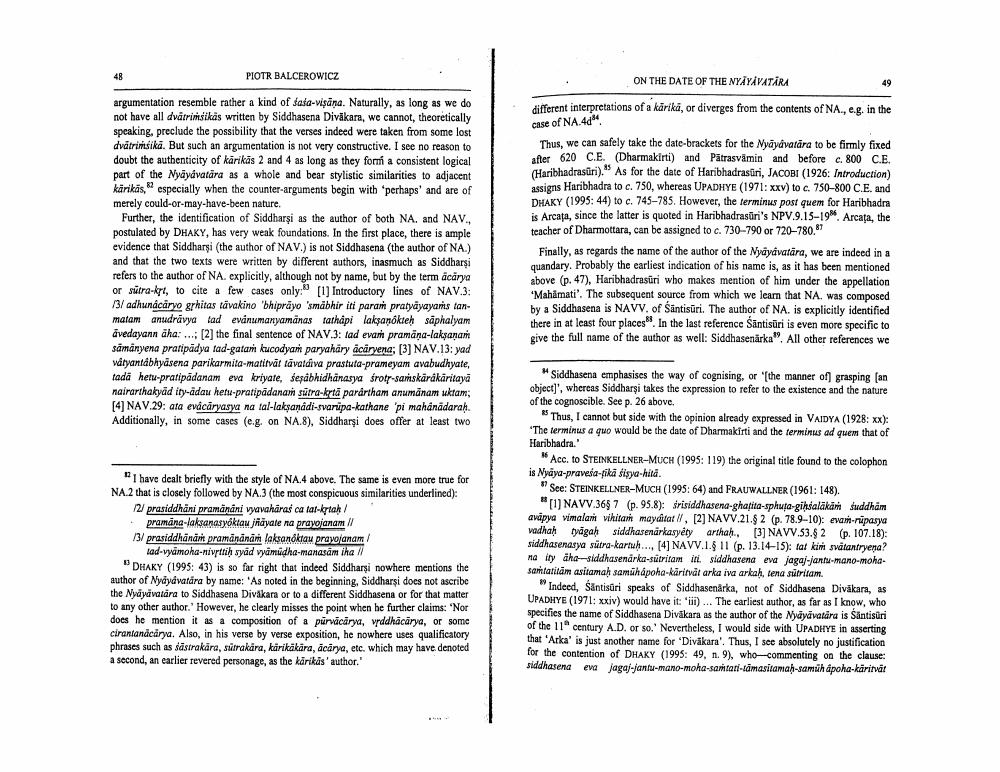________________
PIOTR BALCEROWICZ
ON THE DATE OF THE NYĀYAVATARA
different interpretations of a karika, or diverges from the contents of NA., e.g. in the
case of NA 40
argumentation resemble rather a kind of fasa-visana. Naturally, as long as we do not have all dvätrinsikas written by Siddhasena Divakara, we cannot, theoretically speaking, preclude the possibility that the verses indeed were taken from some lost dvatriitsika. But such an argumentation is not very constructive. I see no reason to doubt the authenticity of karikas 2 and 4 as long as they for a consistent logical part of the Nyayavatāra as a whole and bear stylistic similarities to adiacent karikas, especially when the counter-arguments begin with 'perhaps' and are of merely could-or-may-have-been nature.
Further, the identification of Siddharşi as the author of both NA. and NAV.. postulated by DHAKY, has very weak foundations. In the first place, there is ample evidence that Siddharsi (the author of NAV.) is not Siddhasena (the author of NA.) and that the two texts were written by different authors, inasmuch as Siddharşi refers to the author of NA, explicitly, although not by name, but by the term dcārya or sūtra-kry, to cite a few cases only: [1] Introductory lines of NAV.3: /3/adhunácaryo grhitas tävakino 'bhiprāyo 'smábhir it para pratyayayaris tanmatam anudrávya tad evinumanyamānas tathapi laksanókieh sāphalyam avedayann aha: ... (2] the final sentence of NAV.3. tad var pramana-laksana sámányena praripadya tad-gatam kucodyam paryaháry acáryena; (3) NAV.13: yad varyantábhyasena parikarmita-matitvat tavatdiva prastuta-prameyam avabudhya tada hetu-pratipadanam eva kriyate, seabhidhänasya śrot-samskärákäritaya nairarthakydd ity-adau hetu-pratipādanam sūtra-kota parartham anumanam uklam, (4) NAV.29: ata evacāryasya na tal-laksanádi-svarüpa-kathane 'pi mahanadarah. Additionally, in some cases (e.g. on NA.8), Siddharsi does offer at least two
Thus, we can safely take the date-brackets for the Nyāyavatara to be firmly fixed after 620 C.E. (Dharmakirti) and Patrasvamin and before c. 800 C.E. (Haribhadrasüri)." As for the date of Haribhadrasuri, JACOBI (1926: Introducti assigns Haribhadra to c. 750, whereas UPADHYE (1971: xxv) to c. 750-800 C.E. and DHAKY (1995:44) to c. 745-785. However, the terminus post quem for Haribhadra is Arcata, since the latter is quoted in Haribhadrasūri's NPV.9.15-194. Arcața, the teacher of Dharmottara, can be assigned to c. 730-790 or 720-780.87
Finally, as regards the name of the author of the Nyayavatara, we are indeed in a quandary. Probably the earliest indication of his name is, as it has been mentioned above (p. 47). Haribhadrasuri who makes mention of him under the appellation "Mahamati'. The subsequent source from which we learn that NA. was composed by a Siddhasena is NAVV. of Santisūri. The author of NA. is explicitly identified there in at least four places. In the last reference Säntisüri is even more specific to give the full name of the author as well: Siddhasenarka". All other references we
I have dealt briefly with the style of NA.4 above. The same is even more true for NA.2 that is closely followed by NA.3 (the most conspicuous similarities underlined):
12/ prasiddhani pramānani vyavahāras ca tat-kotah/ + pramana-laksanasyoktau jriyate na pravojanam // /3/prasiddhanári pramanānām laksan kta prayojanam
lad-vyamoha-nittih späd vyāmüdha-manasām iha //
DHAKY (1995: 43) is so far right that indeed Siddharşi nowhere mentions the author of Nyayávatára by name: 'As noted in the beginning, Siddharsi does not ascribe the Nyayavatara to Siddhasena Divakara or to a different Siddhasena or for that matter to any other author.' However, he clearly misses the point when he further claims: 'Nor does he mention it as a composition of a purvācārya, vrddhācārya, or some cirantandcărya. Also, in his verse by verse exposition, he nowhere uses qualificatory phrases such as sāstrakära, sūtrakára, kärikäkära, acarya, etc. which may have denoted a second, an earlier revered personage, as the karikas' author."
* Siddhasena emphasises the way of cognising, or the manner of grasping (an object]', whereas Siddharşi takes the expression to refer to the existence and the nature of the cognoscible. See p. 26 above.
Thus, I cannot but side with the opinion already expressed in VAIDYA (1928: xx): "The terminus a quo would be the date of Dharmakirti and the terminus ad quem that of Haribhadra."
" Acc. to STEINKELLNER-MUCH (1995: 119) the original title found to the colophon is Nyaya-pravesa-tika šisya-hita. "See: STEINKELLNER-MUCH (1995:64) and FRAUWALLNER (1961: 148).
NAVV.365 7 (p. 95.8): srisiddhasena-ghanta-sphusa-gihsalakan fuddham avapya vimalanii vihitam mayditat II, [2] NAVV.21.$ 2 (p. 78.9-10): evan-rūpasya
arthah.. [3] NAVV.53.9 2 (p. 107.18) siddhasenasya sütra-kartuh.... (4) NAVV.1.$ 11 (p. 13.14-15): tar kirit svåtantryena? na ty dha-siddhasenarka-sútritam itt. siddhasena eva jaga-jantu-mano-mohasamantām asitamah samáhápoha-karität arka iva arkah, tena sutritam.
Indeed, Säntisūri speaks of Siddhasenårka, not of Siddhasena Divākara, as UPADHYE (1971: xxiv) would have it: i) ... The earliest author, as far as I know, who specifies the name of Siddhasena Divakara as the author of the Myayavatara is Santisuri of the 11" century A.D. or so.' Nevertheless, I would side with UPADHYE in asserting that 'Arka' is just another name for "Divākara'. Thus, I see absolutely no justification for the contention of DHAKY (1995: 49, n. 9), who-commenting on the clause: siddhasena eva jaga-jantu-mano-moha-samtal-tamasitamah-samih poha-karitat




